Nowadays, it is practically impossible to imagine our life without emojis. They have become such an integral and normal part of our everyday existence that it is hard to believe that once these smiley faces and hundreds of pictograms were simply unavailable for use.
What Are Emojis: A Brief History of Emojis
Only two decades ago, there were no emojis at all! Before those digital images appeared, people would only use emoticons. Although the purpose of those is the same — to enhance the quality of the textual content that the reader sees — they differ in their form. Emojis are digital images, pictograms, while emoticons are emotions and facial representations communicated through text. Emoticons can be created through different combinations of letters and special characters found on the keyboard.
The first emojis as we know them today were created back in 1999 by a coder employed by NTT DoCoMo, a Japanese mobile service provider. The first set of emojis contained only 180 smiley faces, and those were available exclusively for multiple Japanese providers for text messaging and other communications.
It was not until 2010 when emojis became popular worldwide. Them being incorporated into and standardized by Unicode, allowed the world to finally get access to emojis. Since then, the range of emojis available to users of various mobile devices started multiplying. Different developers started creating more and more new emojis to serve a bigger amount of people.
As of now, there are 3,178 emojis total in the Unicode Standard!
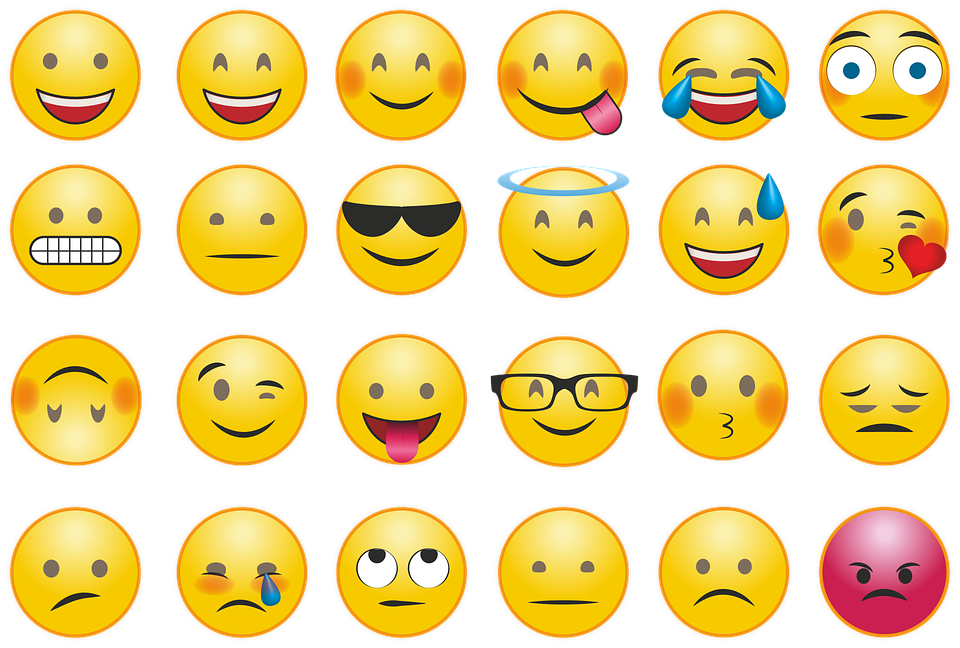
Source: Unsplash.com
What Makes Emojis So Popular?
There is a specific reason why emojis are so popular among internet users. With the main form of communication on the internet still being over text, having access to emojis significantly improves the quality of communication and allows for better expression of your thoughts.
It is right, emojis can convey the emotions that are often quite difficult to put into words!
On top of that, emojis are a visual representation of the word, which means they can be used as a truly international language. Even if you do not speak the same language as the person you are talking to, emojis are universal and will be easily interpreted.
How Can Emojis Become an Essential Part of Your Business’ Social Media Marketing Strategy?
Emojis as a Part of Your Social Media Posts
One of the most common uses of emojis is putting them into social media posts. By doing so, you can make your brand come across as more modern, significantly more interactive and responsive. The reason for this is that by using emojis, you can encourage your audience to mirror your actions and reply back with emojis, too! That will immediately boost your engagement levels and promote your brand online.
According to statistics, Tweets that contained emojis within them saw 25% more engagement, and on Facebook, posts with emojis result in 57% more likes, 33% more comments, and 33% more shares!
On top of that, there is also data to prove that push notifications with emojis saw an 85% increase in open rates and a 9% bump in conversions.

Source: Unsplash.com
Some of the most effective ways of incorporating emojis into your social media posts include the following:
- Using emojis in the body of your post to separate long string of text with some pictorials and therefore making your posts easier to read
- Harvesting your audience’s reaction to something. For instance, you could tell them to leave a comment ???????? if they agree or ???????? if they disagree.
- Asking your audience to describe something without using words. For example, you could wonder what your followers’ plans are, but ask them to only use emojis for replying.
- Making an interactive contest or emoji-based game. Those are always fun to partake in and can raise the number of comments you receive under your publications in no time. You could ask your audience to translate what is coded in your emoji-message and offer a prize for the one who does it the fastest!
Pro tip: You can easily add emojis to your posts using Postfity. Just click on the “emoji” icon in the “Create post” window and select the emoji.

Emojis for Advertising Campaigns
Another big part of the social media marketing that is particularly interested in using emojis is advertising campaigns.
You can attempt at drawing an association between your brand and a particular emoji by launching a social media campaign that includes the aforementioned emoji. A great example of a brand that did that and successfully garnered a lot of brand awareness is Dominos. Back in 2015, Dominos offered Twitter users an opportunity to order pizza simply by sending them a tweet with a pizza emoji!
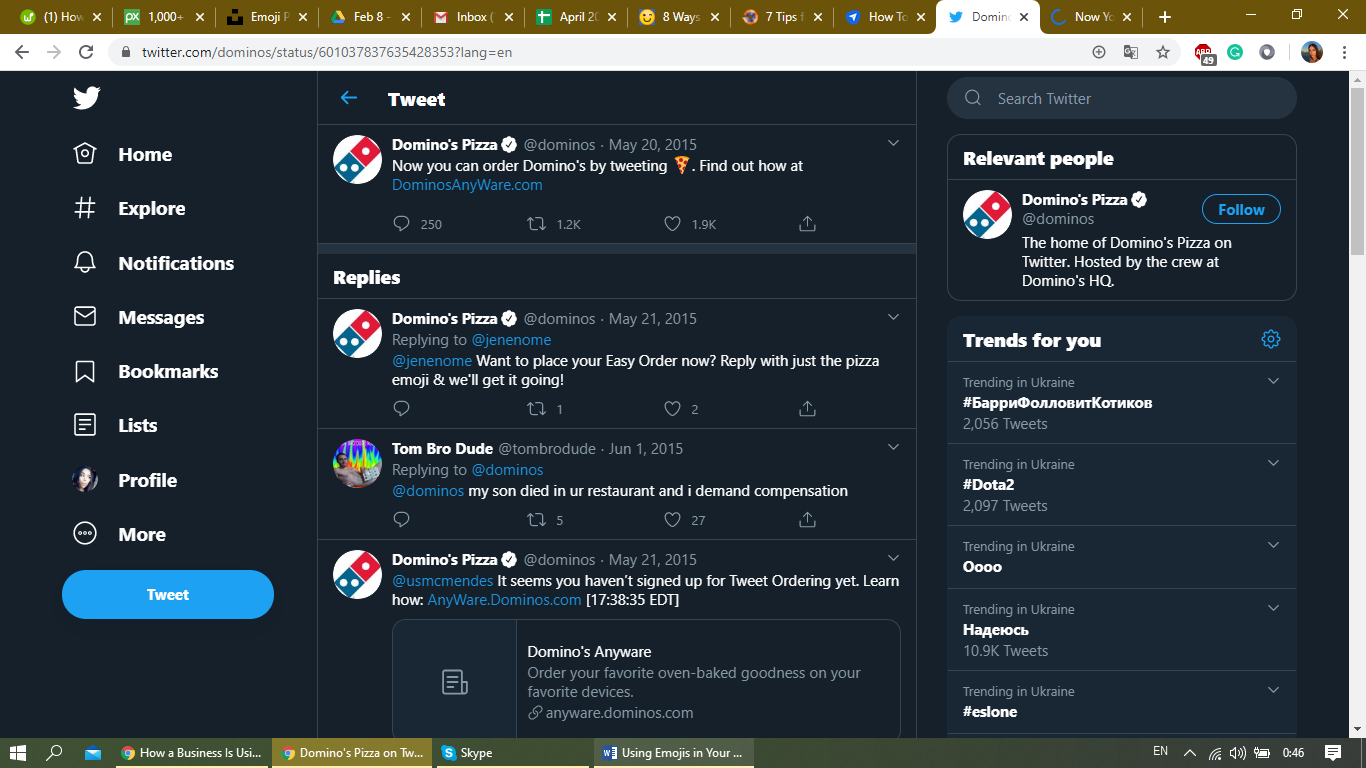
On top of that, you can make your brand come across as more fun by using emojis to show in your ads, too! For instance, you may decode some messages with emojis on the packaging or posters.
Things to Do When Using Emojis as a Business
Make Sure That Your Message Is Clear
One of the first things to remember when trying to incorporate emojis into your brand’s social media marketing strategy is that you need to ensure that the emojis you use convey a certain type of message.
On a number of occasions, people might want to add some fun emojis to their posts or even ads in order to boost their engagement levels and attract the younger audience to their brand, but if you do so without having a clear message set in mind first, you might just end up confusing your audience.
While this could, potentially, bring you some public resonance and raise your brand awareness, you do not want to be famous for all the wrong reasons. Even though people would talk about you, it is a questionable strategy to be known for making a rookie mistake with your emojis.
So, before you launch a genius emoji campaign or even just tweet an emoji riddle, make sure that people can actually decode what you mean and your message will get across easily.
On the other hand, if you manage to deliver a message using only the pictograms, it will be a memorable user experience for everyone seeing that, and will definitely be a marketing success. After all, simplicity is key, and it hardly could get any easier than emojis.
Double Check That You Understand the Meaning of the Emojis That You Use
Another thing to keep a close eye on when working with emojis is understanding the meaning behind them correctly. If you are new to modern online communication, it might seem like an exaggeration to you. Indeed, what could possibly go wrong? After all, emojis are made in such a way that they are clear and straightforward, and can hardly be interpreted incorrectly.
To an extent, this true: designers and digital artists working on the development of new emojis put a lot of effort into ensuring that the emojis available to their clients are both visually appealing and useful. They want to enhance the experience of online communication and make it easier to understand each other. On a number of occasions, emojis do great with fulfilling this mission as they, indeed, do help to add some extra value to the message. Often, emojis convey the emotion in a much more successful way than words ever could. After all, when it comes to writing messages, you are limited to only so many symbols that can accentuate the mood you want to put into your text. On the other hand, emojis can instantly show the exact facial expression you are making as you are typing out your message. The abundance of emojis and their wide variety (people are constantly working on adding new emojis and expanding the range of emotions users can express with these small icons) make it pretty easy to find the one that matches your vibe completely. However, at the same time, the number of emojis that can be used is what can significantly complicate your incorporation of them into your social media marketing strategy. There are several factors affecting this that need to be taken into consideration.
First of all, different operational systems (such as iOS and Android, for example) and even different websites have their own set of emojis. While they will have the same Unicode code, the appearance of them might be different. This can be confusing as on some platforms the pictograms you use might look different, which could affect the message you are trying to deliver.
In addition to that, it is essential for marketers to research the emojis they want to use for their business beforehand and learn if there are any specific popular connotations those have. The first thing you need to do is turn to Emojipedia, the most comprehensive ‘dictionary’ for emojis where you can learn what specific emojis represent. However, sometimes even that is not enough. The reason for this is that the meaning behind certain emojis is often not the same as initially intended by the developers of these images. This phenomenon can be explained by the fact that it is the community that assigns particular meanings to particular emojis. Granted that the most avid emoji users are still teenagers and people in their early twenties, there can be some pretty unexpected associations made with the seemingly innocent emojis.
It can be tempting for businesses to take the easy path and turn to the help of the trending emojis to promote their posts. However, it is important to remember that a lot of the most popular emojis, especially when used in a particular order, are not what they seem. In fact, some of the most seemingly innocent emojis are often employed to make explicit sexual innuendos. So, forget about the excessive eggplant and peach emojis usage unless you want to refer to some particular body parts.
On the other hand, however, do not obsess over it. Unless the emojis you are intending to put into your social media campaign is widely misused by the public, do not worry about them having some underlying meaning. It is possible that even the most random emojis are used to refer to something they do not generally mean in private group chats and small circles.
Nonetheless, here are some of the most commonly misused emojis and what they actually mean:
????
A lot of people use this emoji to express extreme joy or refer to having the so-called jazz hands. However, in reality, this emoji is intended to represent a hug. Indeed, if you look closely you can see the tiny yellow man leaning forward for a hug!
????
Another emoji that is regarded as something it was not intended to be is this image of a woman. Initially, developers wanted her to be a figure suggesting help, but because of her look, people use this emoji to express their sassiness.
✌️
We are all guilty of showing the peace sign a bit too often, even in our messages. However, this is not at all what ✌️ is about. In fact, the aforementioned emoji is a victory sign!
????
At last, one of the most aesthetically pleasing emojis that different businesses like to use to add some mysterious vibes into their social media posts or simply sparkle up their posts is not actually a shooting star. In reality, this is the ‘Dizzy’ emoji that represents the phenomenon of ‘seeing stars’.
Stick with the Emojis that Align with Your Brand
Another extremely important tip to use when trying to use emojis in your social media marketing strategy is the fact that you need to take your brand image into consideration. Not all emojis are created equal, and not all of them carry the same vibe. Some are neutral and can work with pretty much any organization regardless of the niche it operates in, while the others are much more specific and suitable only for a couple of particular businesses.
That being said, it is essential that you have a clear idea of what kind of brand your business is. You need to have a good and thorough understanding of your target audience and the part of it that you intend to engage through the use of emojis. From there, you can start determining which emojis will be suitable for your campaigns and posts and which will not.
For example, if you are a mass-market clothing brand or a fast-food restaurant, you are free to incorporate a much wider range of different emojis than a business that works in the banking or insurance industry. While the latter ones are likely to only be safe with a couple of smiley faces and, perhaps, some arrows from the symbols block, the former ones can experiment with the emojis they include without looking obnoxious. Kissy faces, funny emojis and even a little bit of sass — you can create whichever combination you want depending on the message you are looking to convey.
On top of that, go back to the step talking about delineating your message and think about it within the entirety of your brand. Before hitting the ‘post’ button, you need to make sure that the emojis you use are appropriate for your business. For instance, if your audience is mostly religious, perhaps refrain from using the devil emoji.
Be Inclusive with the Emojis You Use
As stated above, the initial set of emojis back in 1999 was pretty limited. Since then, however, more and more new additions to the range of different pictograms and emojis were made every year if not even more often.
Nowadays, people have an extremely varied choice when it comes to finding the emojis that would match their exact emotion or represent themselves. Indeed, it is believed that with the introduction of humanized emojis people have started associating themselves more with those tiny images hence using them even more.
Therefore, it is particularly important for your brand to make sure that you include all the types of emojis available to you. For instance, if you are going for a thumbs-up emoji or a waving hand emoji, do not just keep using the fair one. Instead, alternate between different emoji skin tones available in the emoji library, or even use all of them at once! On top of that, if you want to put a couple of ‘couple’ or ‘family’ emojis, ensure to take advantage of the emojis that represent gay people as well as straight ones! That will definitely be regarded well.

This will help you to be seen as a much more tolerant brand and prevent you from alienating a part of your market.
Be Strategic When It Comes to Emojis
A great way of hopping onto the emojis trend is by incorporating them into your strategy. While it can be fun to just pull an emoji out of nowhere and surprise your followers with it, it is not a wise approach.
What you want to do is to be consistent with your emoji use. If you stick to a particular emoji that could become a signature emoji for your brand, you will gain much better marketing results from using it than if you did it randomly.
Moreover, once you are familiar with your emojis, you might also start experimenting with them. It can be particularly gratifying to tell a story with your emojis instead of just using them for decoration. Not only that will definitely increase the time your audience interacts with your posts trying to decode them, but will also be viewed as a fun and progressive way of delivering a message.
Get Creative and Create Your Own Brand Emojis
In addition to the previous point, it can be said that you do not necessarily have to use the already existing emojis to draw an association with your brand. Instead, you can be even more creative and come up with some emojis of your own. Those could be either entirely new or custom versions of the popular ones. With the use of different tools available online, you can alter them and use them as a part of your differentiation strategy. For instance, if you are a cosmetics brand marketing manager, you might look into creating some full-glam emojis to promote your products.
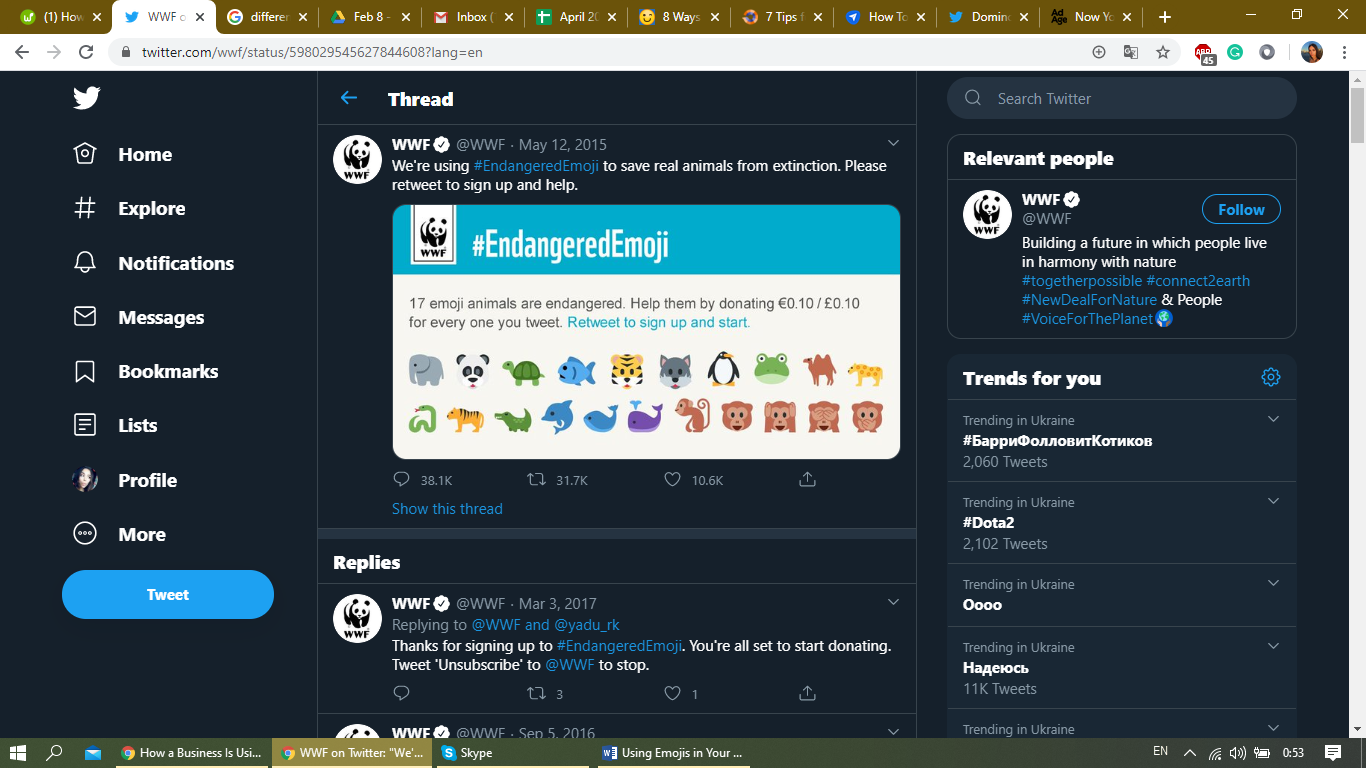
This, however, is only one suggestion. In reality, there are endless ways in which you can express your creativity as a marketer through emojis.
Not only that will attract your target audience’s attention but it will also be an easy and cheap way of raising your brand awareness since people that use your brand emojis will be spreading them for you!
Things to Avoid When Using Emojis as a Business
Do Not Force It
One of the most common mistakes a lot of businesses do when trying to use emojis in their social media posts effectively is going for the popular emojis to boost engagement without giving it any context.
If you see a particular emoji being on a rise, do not rush into putting it into your posts. If it does not fit into your brand image, just skip on this one.
One of the biggest mistakes that a brand can do when trying to spice up their messages with some emojis is using them incorrectly. An example of such a blatant mishap is Hillary Clinton’s tweet that received a lot of backlashes.
In an attempt to appeal to a wider audience and make her content more relevant to the younger generations, Clinton decided to ask her followers to reply to her tweet using only emojis. It would be a pretty successful marketing move had she not chosen a topic so serious.

Emojis are meant to be fun and easy. Student loan, on the other hand, is the very opposite of that. Hence, by offering her followers to describe it using three emojis, Hillary Clinton showed ignorance and an extremely inappropriate condescending tone.
Do Not Overdo It with Emojis
Another problem that a lot of marketing specialists face is the fact that there are so many emojis. Without any exaggeration, with the extensive base of different emojis accessible to us nowadays, words are pretty much redundant and you can objectively replace every other (if not every) word with a funky pictogram.
Indeed, that is possible. However, it is not very effective. A lot of people would consider it to be obnoxious and have trouble trusting your brand’s professionalism.
Emojis Should Be an Enhancement of Your Content and Not the Essence of It
You need to understand that emojis themselves can hardly ever be in the foundation of your social media marketing campaign. They are, indeed, fun to use and can add a lot to your posts, but it is wrong to be using them as the central piece of your content plan.
For instance, if you simply post some trendy emojis without providing any context, you are not to expect your post to blow up and get thousands of reactions.
Instead, you need to subtly enhance your post with emojis. Just think of them as of accessories. Unless otherwise is stated by your particular campaign.
Everything to Know About Emojis in Facebook Ads
As has been mentioned above, one of the most popular ways in which businesses can use emojis is by incorporating them into their advertisements. Even though the platforms for placing your ads are countless, one of the most gratifying social media for communicating with your potential customers and drawing their attention to your brand is Facebook.
Facebook as a platform is well-suited for businesses as it allows them to promote specific products on the pages of it and reach out to a number of people. Moreover, there are also customizable so you can target the people that are a part of your target audience and will be most interested in the product you are marketing.
However, even with Facebook, there are ways to further improve the results of your advertising campaign. Several tests, including a Facebook A/B test, run by different business accounts and published on the Internet have proven the fact that using emojis in your ads posts and even links can be extremely useful.
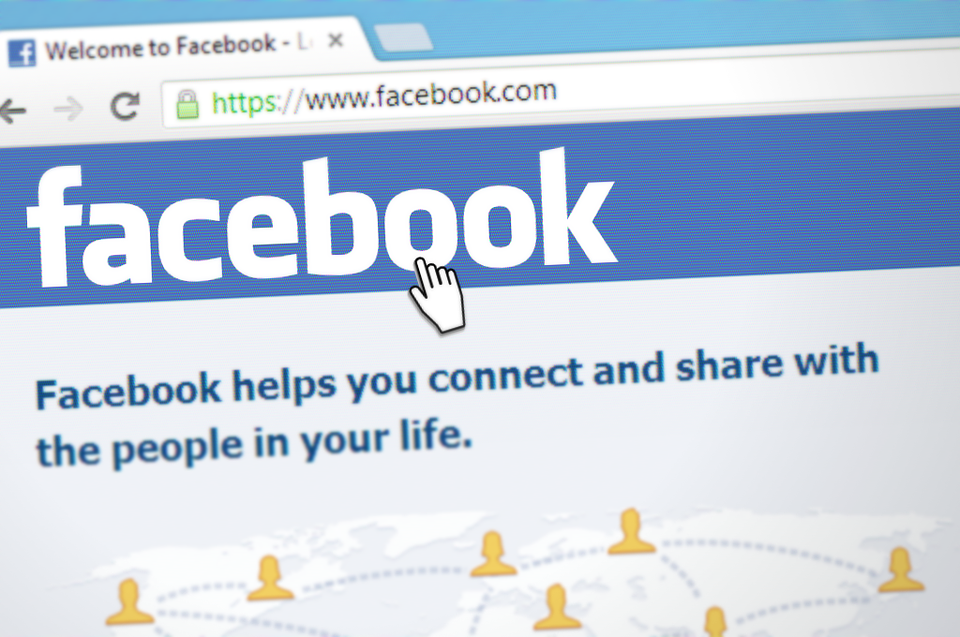
Source: Unsplash.com
There are two main reasons for it:
Emojis have a powerful ability to turn the monotonous text into a funkier piece of writing. It adds some personality to the message you are trying to deliver to your target audience and makes it more relatable to the people that are using emojis in their everyday life. The use of emojis in Facebook ads significantly increases engagement levels and makes people spend more time focused on your ad. In fact, according to the survey, when an emoji appears within a communication advertisement, it generates higher attention along with higher engagement, around 33% more than the same Ad without it. Emojis are, indeed, an eye-catching tool!
On top of that, emojis in Facebook Ads can have a significant positive effect on the CTR of your advertisement. Based on the results of some campaigns posted by various businesses on the Internet, ads that include emojis within them usually show a 30%-40% higher click-through rates. In some rare cases, it was possible to observe a 2000% increase in the number of reactions advertising posts with emojis received if compared to the regular plain text posts.
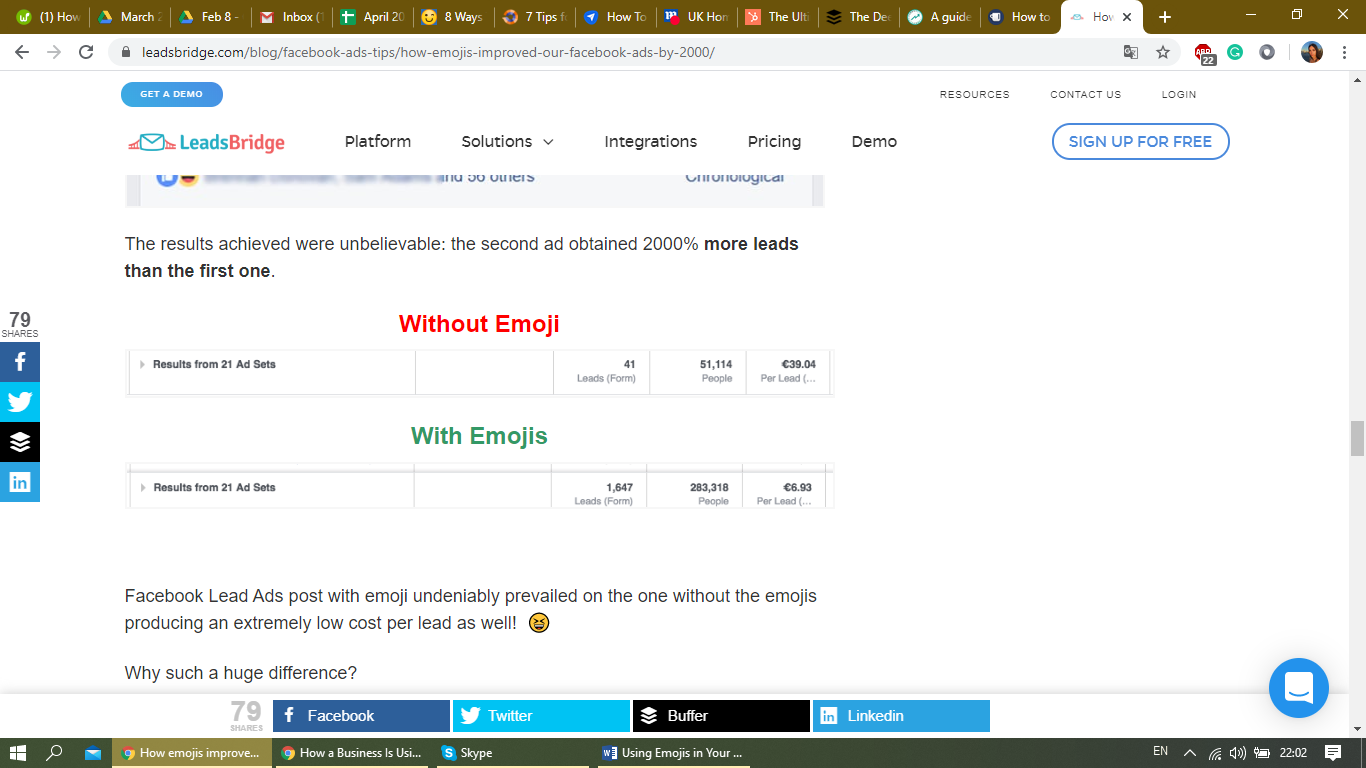
Source: https://leadsbridge.com/blog/facebook-ads-tips/how-emojis-improved-our-facebook-ads-by-2000/
Some of the most popular ways to incorporate emojis to your Facebook Ads include:
- In the body copy
It makes it easier for people to perceive the information as emojis help to break down the text of an otherwise dull and lengthy ad. On top of that, colorful images make potential customers more excited about reading the post they are presented with.
- In the headline
This is a great way to attract the audience’s attention as headlines with emojis in it are usually more ‘loud’ and therefore noticeable. It can create an urge to stop on a particular ad and spend some time interacting with it.
- In the link description
Everything to Know About Emojis in Newsletters
Another way in which you can enjoy the benefits of using emojis and successfully (and also seamlessly!) incorporate them into your marketing strategy by putting them into your electronic newsletters.
Nowadays, people are much less eager to sign up to receive emails from your business as they prefer to keep their email addresses private and spam-free. Therefore, if you do get an email address from your customer, you are already lucky!
But another challenge is to ensure that the recipients of your newsletters actually open them and read them through. After all, for a lot of brands email marketing is still one of the prime ways of internet marketing.
One of the best ways to do that is by adding a couple of emojis into your newsletters to boost engagement. Of course, you need to be strategic when it comes to placing emojis. For instance, you might want to refrain from incorporating a lot of emojis when communicating with new customers who might not be familiar with your brand just yet and therefore could possibly be off-put by a set of random emoticons.
However, once you have introduced yourself as a brand, you might start getting a bit riskier. After all, on a number of occasions adding emojis to your email subject lines has proven to have a positive effect on the success rates of the aforementioned emails. About 60% of the time, the appropriate use of emojis in the subject line of your email boosts open rates by about 25%.
At the same time, however, you need to be cautious. If you misplace an emoji or pick a wrong one, you will likely hurt the open rates, by the same 60%.
The Bottom Line
Emojis are gradually taking over the world, and are becoming a part of our lives. However, despite being so normal, they are still extremely effective in boosting engagement levels when it comes to using them in social media posts. Emojis are fun, interactive and quirky — a great thing to have if you are looking for a little something to spice up your social media marketing and make it more relevant and relatable.
Bio
Cheryl Hearts is a writer and journalist from Boston, Massachusetts. Her passion for writing started at an early age and evolved during the high school years. She enjoyed creating her own stories, so she decided to make writing her career. After earning a degree in Journalism, Cheryl started running her own blog CherylHearts.com where she’s covering topics of great interest to society.


